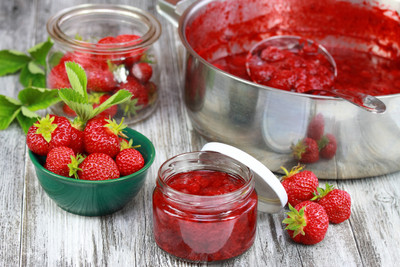Pectin In Preserving
Posted by The Wares Team on 28th Jan 2019
The Roles Of Pectin, Sugar And Acid In Preserving
Pectin is a carbohydrate found mostly in the skin and core of raw fruit. In nature, it functions as the structural "cement" that helps hold cell walls together. in solution, pectin has the ability to form a mesh that traps liquid and sets as it cools. During the making of jam it also cradles suspended pieces of fruit.
Pectin needs partners, namely acid and sugar, to do the job of gelling properly. Acid helps extract pectin from fruit during gentle simmering and helps the gelling process, which will not take place unless the mixture is fairly acidic. If fruits (such as apricots) aren't sufficiently tart, a recipe will call for added lemon juice.
Sugar enhances the strength of the gel by attracting some of the water away from the pectin. In the absence of sufficient water, pectin molecules are more likely to unite with each other. Sugar also acts as a preservative, firms the structure of the fruit, and helps the jam or jelly holds its colour and flavour. If you need to limit your sugar intake you can buy 'no sugar needed' pectin. This product contains a setting agent to replace the action of the sugar. There are also plenty of low and sugar free recipes on the internet.
If you're using commercial pectin, remember that each jam or jelly recipe is designed to maintain the correct balance between pectin, acid, and sugar for the fruit you're using. If you mess with the proportions, don't expect jam or jelly to set properly.
Pectin content varies according to the type of fruit and its ripeness. Some fruits, such as apples, blackberries, grapes and quince are rich in natural pectin and therefore have an abundance of setting power.
Fruits low in pectin are often combined with those high in pectin. Orange (high pectin) and rhubarb jam (low pectin) for instance, blends two fruits with quite different pectin contents. Or commercially packaged pectin can be added to fruits low in natural pectin, like apricots, rhubarb, and strawberries. Commercial pectin is extracted from apples and is natural and quite safe. But remember you can make jam perfectly well without commercial pectin. All you need to do is use a recipe that combines the right fruit and/or adds lemon juice for acid, an apple for pectin and so on.
Its also worth noting that just-ripe fruit contains the highest pectin levels. When fruit ripens further, its pectin content decreases as pectin turns to pectic acid. Though in very ripe fruit, flavours are fully developed, pectin is often past its prime. For best results, mix fully ripe fruit, which has the best flavour, with just-ripe fruit, which has the highest gelling power.
Setting point ( time to fill the jars) can be assessed by removing the pan from the heat and putting a small amount onto a chilled saucer for a couple of minutes to cool. Push the liquid with your little finger and look for small wrinkles in the skin. This is the setting point (103-105 degrees Celsius) if using a jam thermometer. If setting point is not reached, pop back onto a rapid boil for another 5 minutes and try again.
Finally, make sure all your jars and bottles are sterilised well before filling.
Please click here for our full range of preserving jars.

